

I don’t know how to code, and I’m not born into a multi-millionaire family to cover the IT expenses if I were to start a business right now.
I’m pretty lucky that it’s 2024, and I can start my dream business without those.
If I’m selling homemade things online and don’t have a website, I can get a ready-to-use website at Shopify.
If I have my own website, I can use a CRM tool to grow my business, such as Hubspot.
If my website is too complicated, I can create a tutorial guide with UserGuiding to help people have a better experience.
If I hired a person or team for these and many other problems I would face while making and growing my business, I would be in deep debt, and I wouldn’t be able to profit for at least a few years - that is if I’m lucky.
These services just saved me from spending a lot of money and years on learning coding, marketing, analytics, design, etc.
In summary, I got help from SaaS companies and saved time, money, and effort.
So, you may ask:
What exactly is SaaS?
Software as a Service (SaaS), otherly known as Cloud-Based Software, is a software model that is accessible anywhere via the Internet, from any device, without any additional equipment. The product (software) is built into a cloud rather than a data center or a hard drive, making it faster and easier to access and manage.
In other words, using a SaaS product is like hiring an IT team and an analyst who is accessible anywhere, anytime, and are affordable.
SaaS products;
- Are mostly subscription-based, which means that you pay for it as long as you keep using it. This allows you to manage expenses since you can cancel a SaaS subscription without a huge financial loss in case of dissatisfaction.
- Are customizable. SaaS doesn’t mean adopting a ‘’one size fits all’’ kind of product. You can think of SaaS products as a coffee shop. Instead of buying many different kinds of coffee, creamers, machines and supplements, You just walk in and select what you need.
- Are faster. Since they are built into a cloud, the long process of coding, editing, and optimizing can be easily skipped. You can just select the product you need, sign up for it, or buy it, and get up and running.
“I don’t need a hard disk in my computer if I can get to the server faster…carrying around these non-connected computers is byzantine by comparison.”
Steve Jobs
SaaS, being such a beneficial concept, has an extremely fast growth rate, as expected. Since it is a relatively new concept, it still has much room to grow.
Cloud services are now the #1 target of investors due to their rapid growth, and the value that SaaS companies have among all the cloud-based services is massive.
Note: Totals may not add up due to rounding. Source: Gartner (April 2019)
Having said that, it wouldn’t be surprising if I say that the SaaS market grows 30% more each year, right?
How is SaaS Growth different?
SaaS is a newer market that is developing, meaning that it still has a lot of space to grow.
But it grows fast, as I said before. So if you’re thinking about joining the SaaS industry, you might want to hurry up a bit to benefit from the advantages of being an early bird.
The ultimate goal of growth in this industry is to become a unicorn business, which means having a valuation of more than a billion dollars. There are more than 600 unicorn startups already.
But how did they manage to do that?
Simple. There are three main reasons:
- SaaS companies are as new and modern as the concept itself. This allowed them to follow the latest trends, be cut out for the new generations, and determine how the SaaS game is played.
- Most of those businesses had iconic growth hacks. And after getting recognized, they had solid grounds to keep that recognition at the top. Those who were able to sustain their innovations managed to raise.
- The biggest advantage of SaaS is that it’s trackable and measurable. Knowing your statistics allows you to easily detect your weaknesses and work on them and provide you the awareness of your strengths so that you can focus on improving them.
If you are not measuring your growth, you are playing the SaaS game wrong.
At this point, What is Growth Engineering article will help you have better comprehension.
How can I measure SaaS growth?
Contrary to what it seems, measuring SaaS growth is pretty straightforward. How?
Well, you don’t have to have a degree in analytics to keep track of your data. Key Performance Indicators (KPIs) are the biggest helpers when it comes to growth and product measurement.
What simplifies the process the most is that you can always ask a fellow SaaS company who provides the tools you need for help when you’re stuck.
If we’re all on the same page about the ‘’why’’ of SaaS, let’s get to the ‘’how’’:
Best 6 Growth Strategies for SaaS
#1 - Offer freemium versions or free trials
The logic behind this is pretty straightforward. It would be a miracle if people just knew that your product is the one just by looking at it.
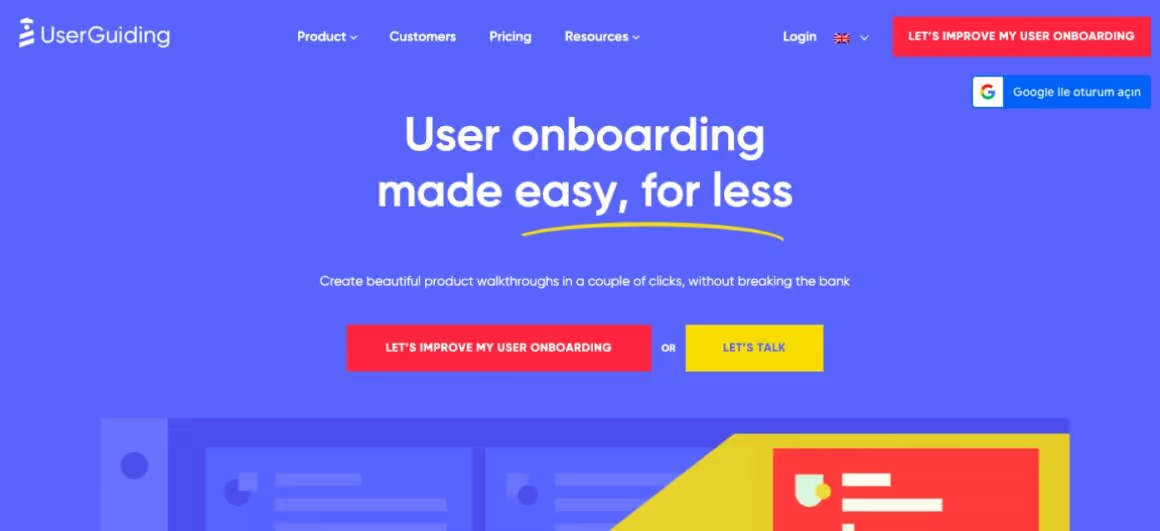
Let people get to know your product. Think of it like sample products at grocery stores. People tend to pay for things that they tried before or recommend them even if they didn’t buy.
The free trial or freemium version needs to be convincing enough, though, to make people buy the product.
But keep in mind that if you have a freemium model and give too much of your services away in the free version, you will likely have a considerable churn rate. No one would pay for the premium while they can get what they need for free.
To prevent that from happening, you should keep an eye close to your KPI statistics to know what customers think your key features are.
#2 - Focus on customer quality
Your customer retention rate is more important than how many customers you have. You should know your audience, and you should know how to address to that audience.
Ten customers that stay with you are way more profitable than a hundred customers that leave you after the first month..
For instance, One mistake that most SaaS companies make is going for discounts. It may seem like it attracts more customers, and your sales go up for a while, but the audience that caught your discount isn’t likely to stay for long. You’re not selling groceries, after all, and you need your customers to stick around for more than a little while.
#3 - Trigger Virality
How many things did you want to try out just because it went viral?
Exactly.
Trending and viral products make people feel special because they’ve heard how special the product is. They’ve seen special people (influencers) use the product and wanted to belong in that special mass.
You might do it with a hack that will plow people’s minds, you might do your advertising in an unusual way that will keep people talking about you.
Learn how to go viral the right way. Check out or latest E-Book about Product Virality.
#4 - Make Your Users Feel At Home
I will be talking about how proper user onboarding can boost user engagement and trust below in the trends, but it is also worth mentioning here.
It is already 2024, and the number of your competitors is probably more than the number of relatives you have. Apart from your pricing and that one feature that makes you stand out, why should the customers choose you?
The answer should be: Because your tools cater to their every need before they know it.
- Your tool should know that they might have a hard time getting used to it - no matter how simple it may look to you. So, you should help them out at the beginning in the way they want. And customers want to learn through either videos or interactive product tours.
- Don't expect them to learn the deepest details of your product at once. Start off with only the key points on the onboarding, and let them learn on their own pace.
- That also means that you should provide a platform - or a UX element - where they can find the rest of the tutorials or help articles when they need them. This could be a checklist or a resource center.
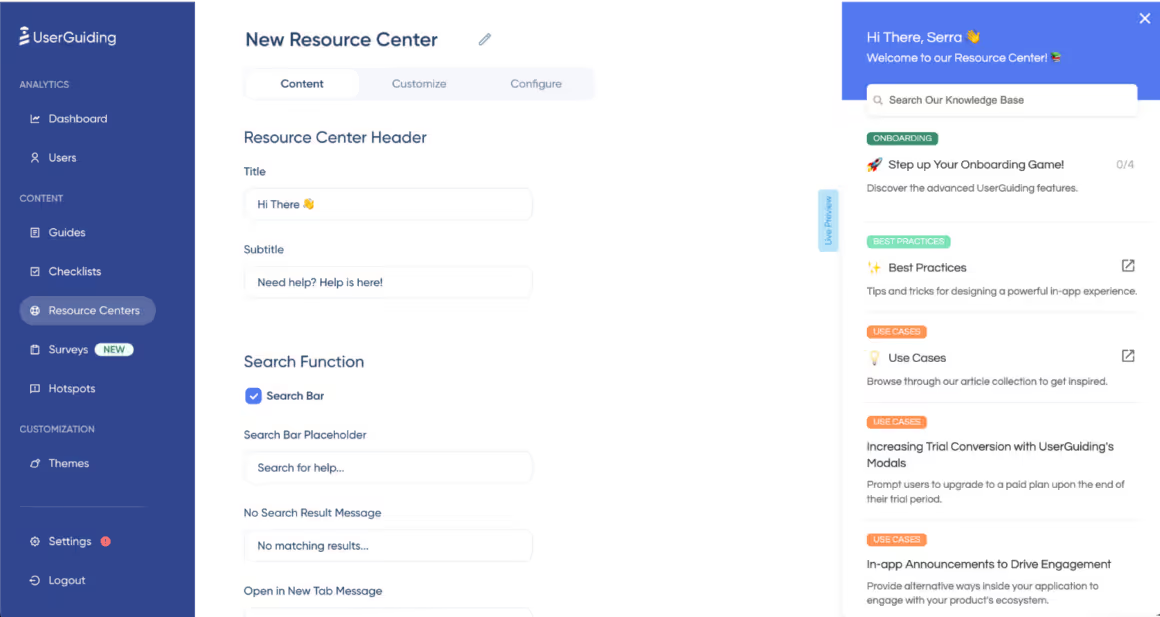
But there is one more thing you have to set straight before the users come find you:
#5 - Don’t just Launch, Launch like a pro
We all know that first impressions are of the highest importance.
The same applies to SaaS products. The way you launch determines how impactful your product can become.
Take Gmail as an example. Gmail didn’t open the platform for public use as soon as it launched. Instead, they only accepted new users by invitation.
It came to a point where Gmail invitations were sold on eBay auctions. Those who didn’t get an invitation rushed for the remaining usernames as soon as they opened for public access.
Long story short, it is unquestionable that a magnificent launch will give you a nice growth momentum.
Wanna know more about how to launch like a pro? Here is a Free E-Book for you.
#6 - Don't forget your team!
One of the things most companies shouldn’t recon without is Their Team.
In the end, the employees are the ones who will be the base of your business, and if they aren’t motivated or qualified enough, your product is likely to collapse.
Study says that the reason why 79% of employees quit their jobs is a lack of appreciation. Imagine finding the best back-end developer for your company and seeing them leave after a couple of months just because they didn’t feel like your company was treating them right.
To be honest, having a fantastic environment is the primary reason why I keep working for my team too.
Best Practices of SaaS Growth from Iconic Companies
Microsoft. Salesforce. Adobe.
Is there one company among these three that you don’t know?
Have you ever used at least one of them anywhere in your business?
I have too. I mean, is there any single person left who hasn’t used Microsoft?
One thing that’s stuck in my brain is, that I have been using Microsoft for a very long time, yet they still manage to be at the top in terms of SaaS growth.
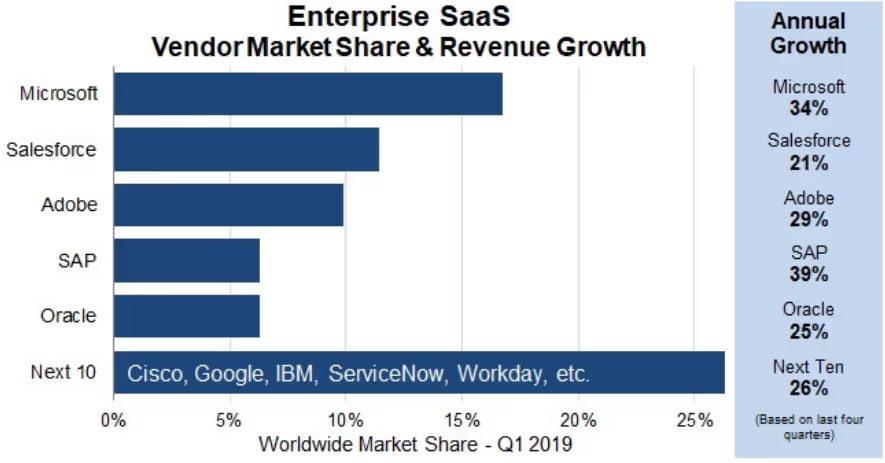
''The Three Musketeers of SaaS'' would be an on-point name for those three, I guess. Let's see why:
Salesforce
When Salesforce was a small startup in Silicon Valley, no one thought that the idea that Salesforce had would be their mentor.
Salesforce is literally the first SaaS company ever.
They started the idea of SaaS by protesting software throughout Silicon Valley.
But how did they manage to stay in the top 3 in the SaaS game?
For a long time, Salesforce kept being the only SaaS product around, but as the numbers of SaaS companies increased, they came up with another revolutşonary idea to create a new game.
As you see, they didn’t stop on ideas after SaaS, Force.com, a PaaS product of Salesforce, was also the first PaaS ever.
3 Best Practices from Salesforce:
- Write free giveaways:
E-books. Webinars. Success stories. Basically, anything that is a little bit more specific and useful than a blog article will make a great impact on your growth, especially if you don’t have a free version of your product, like Salesforce.
- Integrate with lots of other apps:
Two heads are better than one, right? Making it easier for your customers to use your product and supplementary products at the same time, just with a couple of clicks is a great way to be preferred among competing products. Salesforce can be integrated with G-Suite, Slack, Quickbooks, Mail Chimp, Linkedin, Docusign, Jira… You get the point.
3. Use a watermark for your free plan:
Salesforce does not have a free plan, but it is a fact that the ‘’powered by salesforce’’ is a pushing factor of its quick growth. A similar method has been used by Hotmail in its early stages, and a little addition at the end of every email gained them quick and massive growth.
Microsoft
I mentioned that the ultimate goal of any SaaS company is to become a Unicorn, right?
Ladies and gentlemen, Microsoft is the first company to hit $1M ARR ever.
I remember the times when I used to download every Microsoft Office tool separately. That was when Microsoft 365 hadn’t launched yet.
Unlike Salesforce, Microsoft didn’t start as a SaaS company. In 2008, they launched their first SaaS product, Microsoft Azure, and in 2017, Office 365 turned into Microsoft 365.
The biggest reason Microsoft managed to become a top player in SaaS is its collaboration logic.
Even before they migrated to SaaS, Microsoft Office programs were in the highest demand, and people directly thought of Microsoft Word when they needed to write a document.
They thought of PowerPoint and not Google Slides when they needed to create a presentation.
Instead of slowly dying in front of the cloud-based revolutions, Microsoft adopted the new norms of software and quickly became the market leader, even surpassing Salesforce.
3 Best Practices from Microsoft:
- Use the inverted funnel concept for user acquisition
The inverted funnel acquisition literally puts the marketing funnel upside down and generates an inside market that starts after the first purchase. Microsoft used this practice while migrating. They turned their product users into subscribers, meaning that they already had a market that is willing to explore more of them, and gave them their latest release.
- Build a growth engine into your product
Paid advertising is not always the most effective way to increase growth and can be costly. Instead, convincing people to share your product is a proven way to rapidly get new users who are ready to turn into customers. In Microsoft’s case, being able to edit an existing Word or Excel file makes things faster. The more the people around you use the product, the easier it will become to communicate.
- Don’t lie about your product, and never use hidden fees
Personally speaking, I hate it when I download a free app, and it turns out to be a paid product as soon as I open it. Instead of keeping it and making the purchase, I just deleted it since I’m already disappointed. Microsoft explains everything that is covered in the package before you make the purchase, and I never had to pay any additional fees after making the purchase.
Adobe
Adobe is another company that didn’t start out as a SaaS company but migrated to it.
With a 35-year background, Adobe is a company that had a similar transition process and result to Microsoft.
An existing customer portfolio that is happy and loyal, good timing, and an excellent execution of migration to SaaS.
3 Best Practices from Adobe:
- Your sign-up form should be short and clear:
People like things to be fast. Keeping the sign-up form short and simple could increase the number of loyal customers since asking for long and detailed information can be misinterpreted as a security breach.
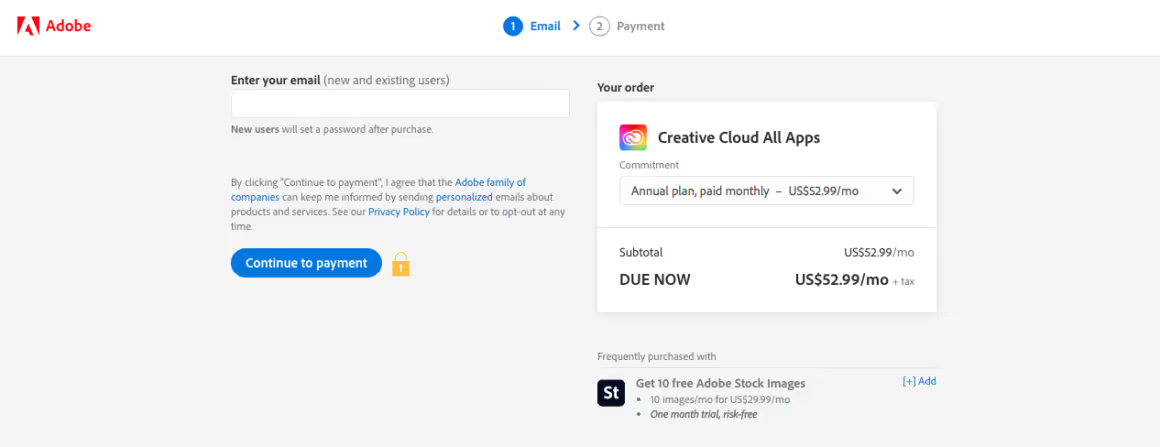
- Get into review sites
Anyone who needs an editing or designing tool knows about Adobe products, and there isn’t one person who didn’t search for cheaper options. In the end, most of them ended up getting Adobe products. Why? It’s almost common sense now that Adobe is almost irreplaceable. Positive or negative, all reviews about the product elevated it, and now, knowing how to use an Adobe product has become a must in some industries.
- Shorten your free trial period
The free trial period of Adobe is 7 days. Most products usually offer a month-long free trial, but it is proven that shorter free trials trigger a sense of urgency and FOMO (fear of missing out) in people, and they result in higher conversion rates.
Mind-blowing, aren’t they?
I’m not telling you that these are the only ways to grow your SaaS business. You don’t have to copy a top company and expect to exceed them.
So where can you start?
Right here:
6 SaaS Growth Trends to follow in 2024
#1 - Investing in Proper Onboarding
User Onboarding is the process of introducing the product to the users and assisting them to the point where they will become loyal customers. User Onboarding is neither leaving your users with the product tour alone nor getting involved in everything they do and ‘’teaching’’ them what to do.
There are thousands of companies who treat their customers as if they were diamonds.
If you’re not one of them, the customers won’t be yours. No matter how cheap or perfect your product is.
Would you eat at your local Mcdonald's again if a manager yelled at you as soon as you entered it? Would you ever drink boba again if you found no one to help you get served?
Nope.
Everything has to be nice, neat, and close enough to perfect. Being a SaaS, PaaS, B2B, or B2C, doesn’t matter.
If you are in search for a user onboarding tool, or digital adoption platform, then let me introduce you to UserGuiding.

Here’s why UserGuiding is your to-go choice:
- UserGuiding is 100% code free! No technical knowledge needed at all.
- UserGuiding lets you create modals, tooltips, hotspots, surveys, resource centers, checklists, announcements, and banners - all in one tool.
- With Userguiding, you can create multiple interactive guides and checklists according to your users’ needs.
- UserGuiding is fully customizable. You can use your logo, your color palette, your font, and your visuals as you create YOUR USERS’ interactive onboarding experience.
- Last but not least, UserGuiding provides advanced analytics for all the steps your end-users go through so that you can recognize their patterns and provide them the best service, before they even realize they need it.
To top it all, UserGuiding is the most affordable tool of all, with prices starting from $174/month.
#2 - Developing a White-Label SaaS
Sometimes, you know how to develop a product and don’t know how to sell it, and sometimes you are a marketing mastermind but not a developer or engineer.
This is when White Label SaaS comes in.
White Label SaaS is developing a product, finishing all the testing and designs, and selling it to another company rather than marketing it yourself.
The reason why white-label SaaS is a trend to follow;
Is because it enables developers to focus on creating better products without having marketing or growth concerns while giving companies to get a ready-to-use product rather than spending time on creating one.
White-label SaaS is also popularizing because developers who proved themselves as "good" create side products to sell as white labels, which spices up the market.
#3 - Vertical SaaS
Instead of aiming to get the attention of a vast majority, Vertical SaaS companies target a specific industry.
Those who studied or graduated recently probably heard of Quizlet. Quizlet is a perfect example of vertical SaaS since its target is pretty specific: teachers, parents, and students.
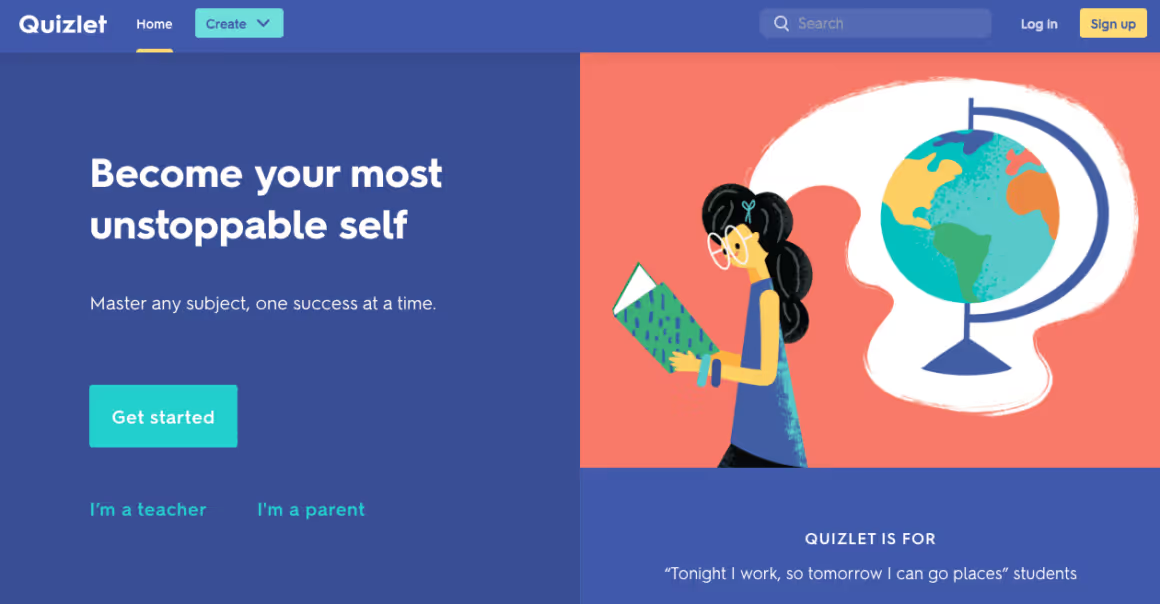
The easiest way to develop according to user demand would probably be serving a mass that shares the same goals and concerns. Therefore, Vertical SaaS makes it easier to please the majority of that certain group.
#4 - Micro SaaS
Micro SaaS products are pretty straightforward. They focus on one single purpose and do that only.
Sheety, for instance, is a micro SaaS product that helps you turn your spreadsheets into APIs.
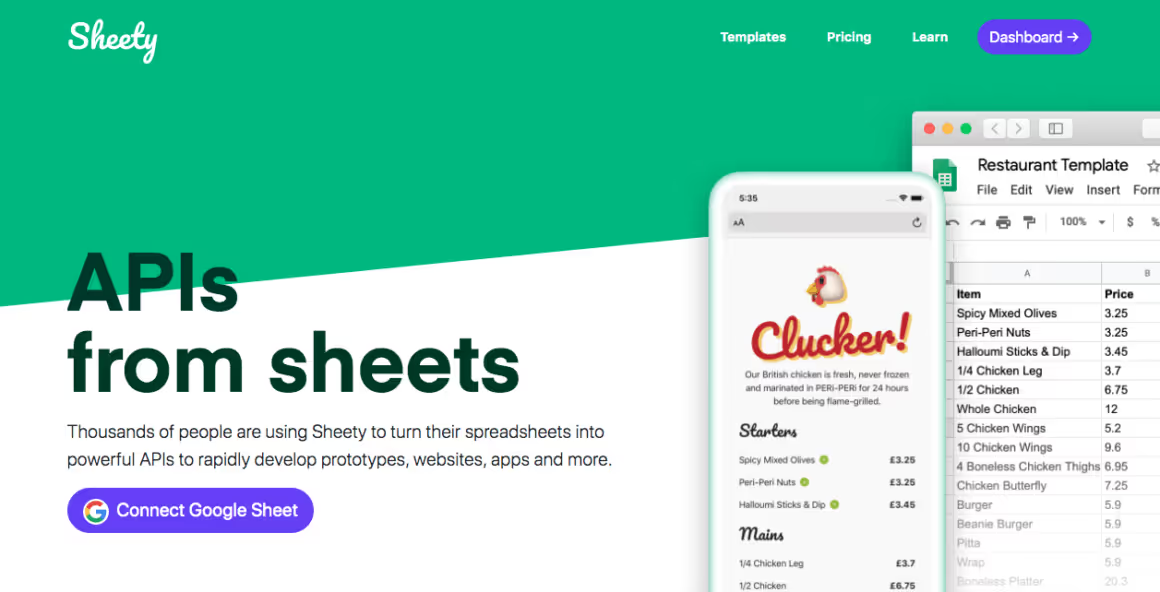
Micro SaaS businesses are usually run by smaller teams of 2 or 3 rather than bigger companies with dozens of employees. This allows them to focus on customer-based income and frees them from the "investor-seeking" process and stress.
#5 - Artificial Intelligence (AI)
AI is a highly trending concept, not only in SaaS.
It became common sense that AI can make our lives easier. In the SaaS world, AI helps analysts and developers to get rid of some of their burdens.
Integrating AI into the product makes customer-specific customization easier.
Grammarly, for example, uses a language learning algorithm that is an AI, similar to Google Translate, making it easier to develop and fix bugs.
HubSpot and GitHub are some other examples of SaaS companies that benefit from the advantages of AI.
#6 - Low code (or no code) approaches
It is no secret that people are living for things that make their lives easier and faster. Just like the whole concept of SaaS making developing easier, low code (or no code) approaches to make the SaaS market more accessible.
''The future of coding is no coding at all.''
Chris wanstrath - ceo of github
Skipping the coding process is both cost and time-efficient, which is precisely what is mainly needed these days.
Going for a no-code approach doesn’t mean that developers will be underrated; it just means that they will have more time to focus on what’s missing, rather than having to create something from scratch.
#7 - Mobile Optimization
According to a study by 11k users of RescueTime, people spend 3 hours and 15 minutes on their phone every day, while this number decreases to 90 minutes per day (for leisure purposes).
This should be enough to point out the importance of optimizing your product for mobile devices, right?
I myself prefer to use my phone rather than my computer whenever I can because sitting in front of the computer gives me backaches, and I can’t carry my desktop anywhere (especially the toilet).
Conclusion
SaaS, though seems really complicated, is one of the most beneficial and new concepts within the 21st-century market.
Even though it’s newer, the competition is too tight to overcome without knowing a key aspect or two of how to grow a SaaS business in 2024.
New trends emerge every day. New hacks are presented to the market every time a new company rises to the top quickly, a new method is called ‘’the best’’ every other day.
There is no need to be afraid or overwhelmed, though. The logic behind SaaS is not that complicated, and it is up to your imagination after you understand the basics that are listed above.
I wish you an enjoyable ride throughout your SaaS journey. And don’t forget to stay safe!
Frequently Asked Questions
Why do SaaS companies need to growth hack?
Growth hacking is one of the most effective and fastest-resulting methods of SaaS growth. Since the competition is tighter than ever in 2024, having a headstart is almost a must to gain recognition before running out of sources.
What is the average growth rate for a SaaS startup?
Average growth rates differ in the sizes of companies. While %80 growth for a $3M SaaS company is below the average, the same growth rate is twice as much as the average for a $20M SaaS company.
What is organic growth in SaaS?
Organic growth is increasing KPI results with engineering or developing rather than external effects such as advertising or acquisition channeling.

















.svg)
.svg)
.svg)
.svg)
.svg)

.svg)
.svg)












.svg)
.svg)




.png)

















